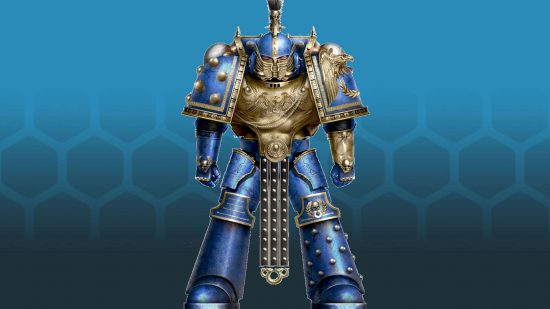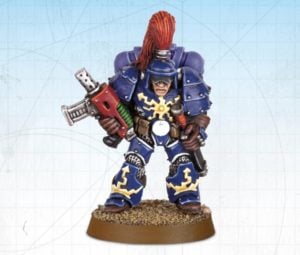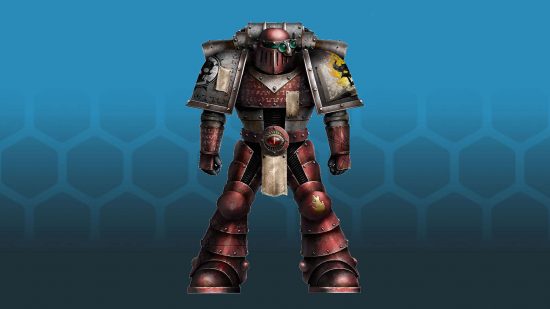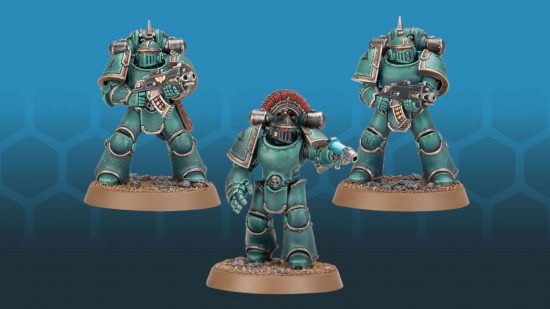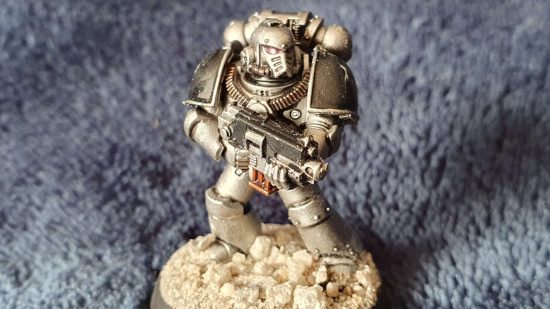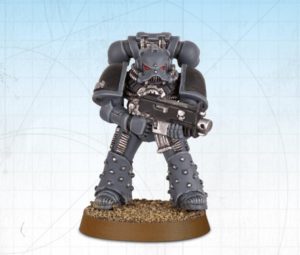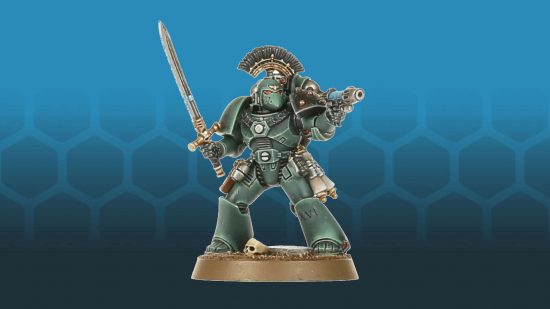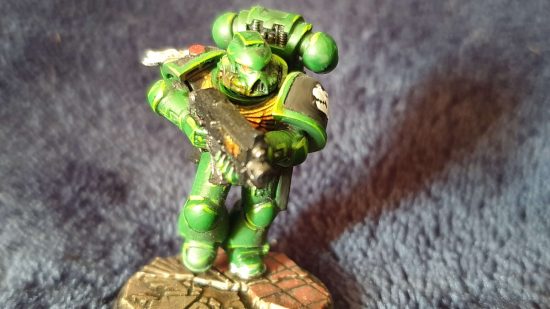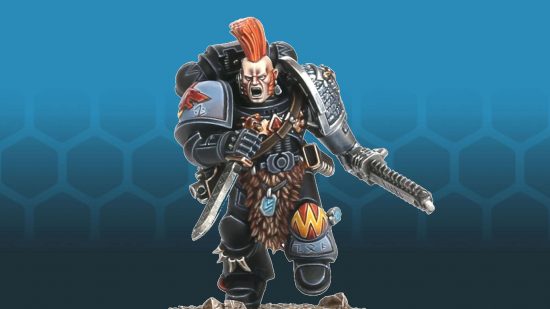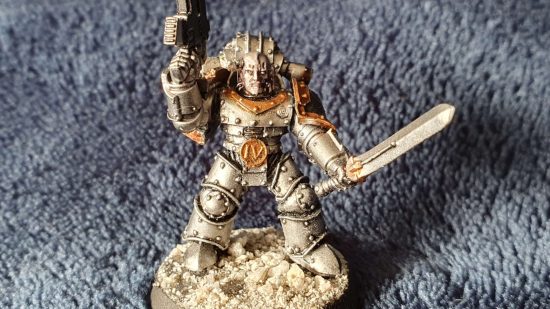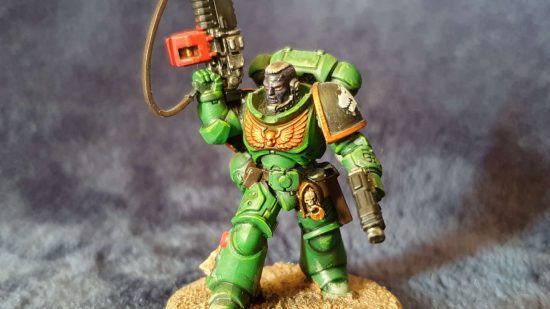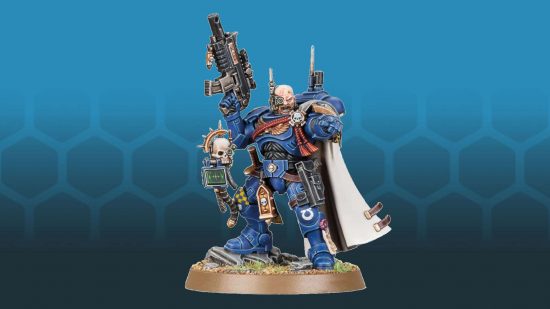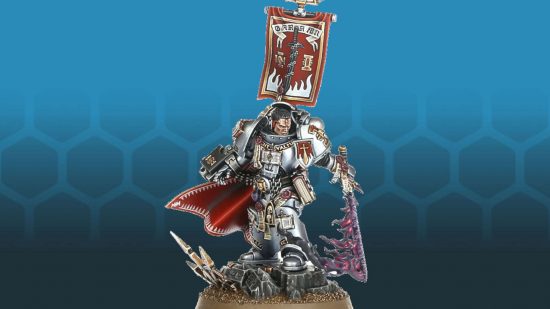If you recognise just one thing from Warhammer 40k, you probably recognise Space Marine armor. This highly advanced power armor enhances their strength, heightens their senses, and shields them from harm, allowing Space Marines to march headlong into the most deadly conflicts, heedless of enemy attack.
If you’re new to Warhammer 40k, we have separate guides that will introduce you to the Space Marines, as well as the distinctive cultures of the Space Marine Chapters – and there are many other Warhammer 40k factions to explore.
Here’s everything you need to know about Space Marine armor in Warhammer 40k:
- What is Space Marine power armor?
- Mk 1 Thunder Armor
- Mk 2 Crusade Armor
- Mk 3 Iron Armor
- Mk IV Maximus Armor
- Mk V Heresy Armor
- Mk VI Corvus Armor
- Mk VII Aquila Armor
- Mk VIII Errant Armor
- Artificer Armor
- Mk X Tacticus Armor
- Mk X Phobos Armor
- Mk X Gravis Armor
- Mk X Omnis Armor
- Aegis Armor
- Terminator Armor
What is Space Marine power armor?
Space Marine power armor is some of the most highly advanced technology in the Imperium of Man. It comprises multiple layers: an inner body-glove of flexible, yet robust mesh; an exoskeleton of metal, servos, and electromotivated fibre bundles that provides the wearer superior strength; and plates of ceramite armor, resilient against all but the most devastating enemy attacks.

Power armor is incredibly heavy, so much so that even a genetically enhanced space marine struggles to move it unaided. The back-mounted power pack supplies the necessary energy to move in the armor, enhancing the wearer’s strength to new heights.
The helmet contains a variety of advanced autosenses, retinal displays, and machine spirits that provide the wearer unparalleled awareness of the battlefield. Internal stimm injectors, pain suppressors, and self-repair mechanisms keep a marine fighting in the heat of combat. The armor can be fully sealed, protecting the wearer against toxins or the vacuum of space.
Each Space Marine is implanted with “black carapace”, a layer of subdermal tissue that bonds to the wearer’s nervous system, and with neural implant sockets across his body. This allows the Marine to bond directly with his power armor via neural spikes, granting him unparalleled control and freedom of movement.
Mk I Thunder Armor
The very first power armor was worn by the Thunder Warriors, a precursor to the Space Marines who fought alongside the Emperor of Mankind during his reconquest of earth at the end of the Age of Strife. Thunder Armor was not fully enclosed: it provided protection and enhanced strength to the arms and upper body, and had an open visored helmet.
Mk II Crusade Armor
The first mark of power armor worn by Space Marines saw service at the very end of the Unification Wars, and throughout the Great Crusade to conquer the galaxy. Mk II Crusade Armor was the first fully enclosed suit of power armor; it could be environmentally sealed, protecting the wearer from toxic environments or even in the void of space.
Each armor piece is made from multiple banded segments, and the power cables are exposed at the abdomen, down the backs of the limbs, and on the inner thigh.
Mk III Iron Armor
Mk III Iron Armor is a variant of Mk II power armor built for close-quarters and high-intensity combat, including void-ship boarding actions, urban warfare, and sieges. Additional armor plates on the plastron and front of the limbs provide extra protection, while shielding the power cables.
Mk IV Maximus Armor
MK IV Maximus Armor was a highly advanced suit of power armor that entered service towards the end of the Great Crusade, particularly after Horus’ appointment as Warmaster. Lighter than Mk III Armor, it featured superior sensory and computational capabilities.
Once Horus committed to his rebellion, but before the massacre at Istvaan III, he ensured supplies of Mk IV armor were preferentially deployed to traitor forces.
Mk V Heresy armor
Mk IV power armor proved extremely difficult to maintain during the Heresy, and so field repairs were common, removing advanced systems, patching in additional armor plates using monomolecular bonding studs, and so on.
Eventually this resulted in an ad hoc production model, Mk V Heresy armor, a mongrel suit with exposed power cables and extensive use of monomolecular bonding studs to hold together layers of inferior armor plating.
Mk VI Corvus armor
Mk VI Corvus armor was named after Corvus Corax, Primarch of the Ravenguard, whose legion field tested the armor before the outbreak of the Heresy. A light armor model, it featured an extended “beaky” muzzle packed with additional sensor tools. The plans for Corvus Armor were stolen by Alpha Legion operatives, and loyalists and traitors alike made use of the armor during the Heresy.
Mk VII Aquila armor
Mk VII Aquila Armor was first used by Imperial forces at the Siege of Terra. It lacks the advanced features of Mk IV or MK VI but offers solid protection, with very little exposed power cabling and a reinforced plastron. This usually bears a device – sometimes the eponymous aquila, often an imperialis (winged skull).
Mk VIII Errant armor
Mk VIII Errant armor is the most advanced production model power armor available to firstborn Space Marines in the 41st millennium – though externally, the main visible difference from Mk VII armor is a raised gorget that protects the wearer from bullet deflection. Errant armor is used extensively by the Deathwatch.
Artificer armor
Each suit of Artificer armor is a hand-crafted masterpiece constructed by the a Chapter’s most advanced armorers. Reserved for the most revered heroes, artificer armor is amongst a Chapter’s most treasured relics – though during the time of the Great Crusade, it was common for line sergeants to sport Artificer armor.
Mk X Tacticus armor
Invented by the Adeptus Mechanicus arch-magos Belisarius Cawl, Mk X power armor is worn exclusively by Primaris Space Marines. Studying the design reveals similarities with the void armor of the Leagues of Votann, an offshoot of the human species that employs technology preserved from before the Dark Age of Technology.
Mk X power armor is designed to be easily reconfigured with the addition or removal of modular components. The most common variant is the all-rounder Mk X Tacticus armor, worn by Intercessors, Hellblasters, and other line troopers.
Mk X Phobos armor
Mk X Phobos armor is stripped back and optimised for stealth. While it offers similar protective capabilities to Tacticus armor, it employs sound-baffles and augury scramblers that enhance its wearer’s infiltration capabilities.
Mk X Gravis armor
Mk X Gravis armor is heavily uparmored, designed for close-quarters combat or to port heavier weaponry. It is notably slower than Tacticus armor, but greatly increases its wearer’s survivability. It can also be fitted with heavy jump packs and retrojets that allow for orbital insertion.
Mk X Omnis armor
Mk X Omnis armor is a curious blend of elements from both Phobos and Gravis, designed to allow jump-pack troops to wield heavy weaponry while still supporting the advance of Phobos-equipped Vanguard forces.
Aegis Armor
Aegis Armor is worn exclusively by the daemon hunters of the Grey Knights. Amongst the finest power armor the Imperium is capable of producing, it is engraved with hexagrammatic wards that protect the wearer’s soul as surely as its blessed ceramite plates protect their soul.
Terminator Armor
Terminator armor – or to give it its full title, tactical dreadnought armor – is massively up-armored and up-gunned compared to normal power armor, equipped with powerful personal forcefields. You can check out our separate guide to Space Marine Terminators to learn more about the different marks of terminator armor.
Space Marines are always part of Warhammer 40k starter sets in part because power armor is a great material to learn painting with – lots of big armor plates. If you’ve got your first Space Marines and want some tips on how to start getting their power armor ready for parade, check out our guide to painting miniatures.
